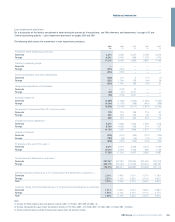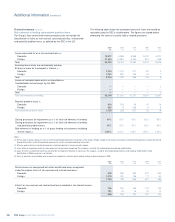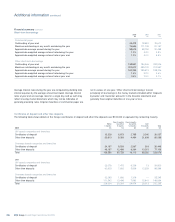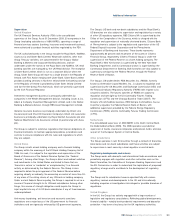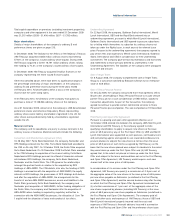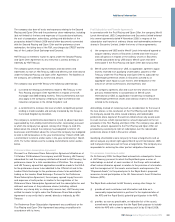RBS 2009 Annual Report Download - page 362
Download and view the complete annual report
Please find page 362 of the 2009 RBS annual report below. You can navigate through the pages in the report by either clicking on the pages listed below, or by using the keyword search tool below to find specific information within the annual report.Additional information continued
RBS Group Annual Report and Accounts 2009360
Economic and monetary environment
Conditions remained difficult across much of the world economy in 2009.
In the first three months of the year, the global slowdown intensified, with
many industrialised economies recording the fastest contraction in output
for a generation. The synchronised nature of the downturn resulted in a
marked deterioration in international trade, as firms pared back inventories
and cut orders. Financial market conditions remained turbulent, with
equity prices touching a low of 60% below their 2007 peak in March, as
rising job losses added to pressure on consumer spending. Policymakers
took unprecedented steps to combat the decline, augmenting earlier
fiscal stimulus packages and embarking on extraordinary monetary policy
actions. A number of central banks cut interest rates further, made
significant asset purchases and provided additional liquidity to financial
markets. Growth in emerging markets held up moderately well by
comparison, with the exception of Eastern European states that suffered
acutely from balance of payments difficulties.
Signs of stabilisation began to emerge in the second quarter of 2009.
Germany, France and Japan announced a return to economic growth in
the three months to June, and the pace of recession abated elsewhere.
Strains in money markets began to ease, as evidenced by a gradual
decline in inter-bank lending markets towards policy rates and a
narrowing of credit spreads. Asset prices began to recover from their
first quarter trough, supported by substantial liquidity provision from
central banks. Prospects for profitability and employment remained
challenging, as workers continued to face difficult labour market
conditions and revenues were squeezed. Commodity prices staged a
recovery in the second half of 2009, supported by increased optimism
for economic prospects and more resilient demand conditions in many
emerging markets where growth is more resource intensive.
The UK economy contracted as much in the first quarter of 2009 as
during the entire 1990s recession. Activity continued to contract in the
second and third quarters, but the pace of decline moderated.
Significant slack was evident with businesses operating well below full
capacity and the unemployment rate rising to c.8%. Lower consumer
spending acted as a significant drag on growth as households grappled
with falling employment and weaker average earnings growth. Weak
demand conditions at home and abroad, a high level of spare capacity
and the uncertain outlook resulted in a sharp decline in business
investment. Despite the early recovery in the UK's major trade partners,
exports failed to deliver a significant boost. Sterling strengthened
modestly from its January low in trade weighted terms, but remained at
competitive levels against major currencies compared to the pre-crisis
period. Inflation fell back from 5.2% in September 2008 to below the
Bank of England’s 2% target in June. Inflation remained above 1%
throughout the year – in contrast to bouts of falling prices in the US and
euro area – in part the result of a weaker exchange rate.
The Bank Rate was reduced from 5.0% in October 2008 to 0.5% in
March 2009. This brought the base rate to its lowest level in the Bank of
England’s 316-year history. With interest rates approaching the zero
bound, policymakers embarked on an asset purchase programme,
know as quantitative easing (QE), to provide further support to the
economy. Initially £75 billion was allocated for asset purchases, which
was expanded to £200 billion over the course of the year. The impact of
QE has been credited with reducing the long-term cost of borrowing for
corporates and preventing deflation in the wider economy, though the
counterfactual – the prevailing state of the world if QE was not
undertaken – is unknown.
In the US, the recession was at its most severe in the first quarter of
2009. The economy contracted at 6.4% quarter-on-quarter annualised
rate, but stabilised in the second quarter and returned to growth in the
third quarter. Additional fiscal stimulus measures in 2009 helped to
support spending on autos and encourage a return of buyers to the
moribund housing market. Lower house prices also boosted
affordability, and as prices bottomed out in the middle of the year,
activity gradually picked up. But conditions remain difficult. Between
January 2008 and December 2009 payroll employment declined by
eight million, sixty percent of which occurred in 2009. Labour market
weakness is likely to act as a drag on consumer demand for some time.
Continued dollar weakness provided a boost to net exports in the
second half of the year.
The Federal Reserve had lowered policy rates to 0.25% in December
2008, leaving no room for further rate cuts. Programmes to help
normalise conditions in financial markets and support liquidity were
extended in 2009. In an effort to lower long-term market interest rates,
the Federal Reserve announced that it would purchase $200 billion of
Government Sponsored Enterprise debt, $1.25 trillion of mortgage
backed securities, and $300 billion of long-term treasury securities. Long
yields fell somewhat in the middle of the year but recovered by year end.
The Eurozone entered 2009 on a similar footing to other developed
economies, contracting sharply in the first quarter before returning to
growth in the three months to September. However, there was significant
variation in the performance of economies within the region. Germany’s
downturn was deep, with activity contracting by 6.7% between the
second quarter of 2008 and the first quarter of 2009. Growth returned
in the second quarter of 2009. The recession in France was similarly
short but not as deep (with a 3.5% contraction in output during the
recession). Peripheral economies with higher debt levels, like Ireland
and Spain, were hit hard by rapid and steep rises in unemployment and
an extended period of contraction.
The European Central Bank reduced its main policy rate from 2.5% at
the beginning of the year to 1% by May 2009, and embarked on a
modest programme of asset purchases (€60 billion of covered bond
purchases were announced in May to reduce longer rates). It also
adopted a policy of unlimited liquidity provision to euro area banks.
Nevertheless, lending to households and businesses fell, reducing the
rate of money supply growth to almost zero at year end. Consumer
price inflation across the single currency area was negative for six
months, before returning to positive territory in October. The euro's
strength helped to put downward pressure on import costs, but also
threatened to act as a drag on the recovery by reducing the
competitiveness of the region's exports in global markets.
The retrenchment in international trade in late 2008 had severe
consequences for the economies in Asia Pacific, some of which saw
exports fall in excess of 50% year on year. The intensification of the
downturn in the first three months of 2009 further exacerbated this
contraction, reducing industrial output and leading to rapid rises in
unemployment. Government stimulus packages introduced at the end of
2008 bore fruit in the second quarter of the year, combining with industry
restocking to mark a return to moderate growth across much of the
region. Expansionary fiscal policy in China helped the economy to
bounce back to 9% growth year on year in the third quarter of 2009, but
here, as in many neighbouring economies, private sector demand
remained soft, leaving economies reliant on government support in 2010.





